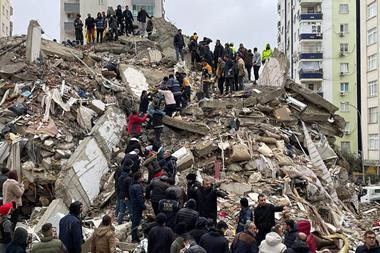Contingent BI claims spike due to broken supply chains, cyber claims remain elevated and inflation will add to claims severity, finds AGCS
Over the past five years, fire and explosion, natural catastrophes and faulty workmanship or maintenance have been the major causes of loss by value of insurance claims, according to the “Global Claims Review 2022” from Allianz Global Corporate & Specialty (AGCS).
“Insurance claims from companies have become more severe over the past five years due to factors such as higher property and asset values, more complex supply chains and the growing concentration of exposures in one location, such as in natural catastrophe-prone areas,” says AGCS chief claims officer and board member Thomas Sepp.
“The future does not look brighter anytime soon. Companies and their insurers have shown resilience to weather the loss impact of the pandemic, but the ongoing war in Ukraine, a spike in the cost and frequency of business interruption losses and the sustained elevated level of cyber claims are creating new challenges.
”At the same time, the top two causes of claims, fires and natural hazards, remain significant loss drivers for companies. Last but not least, the impact of soaring inflation around the world will bring further pressure on claims costs.”
Inflation puts undervaluation of assets in the spotlight
Ultimately, inflation brings pressure on claims costs from multiple angles. Property and construction insurance claims, in particular, are exposed to higher inflation, as rebuilds and repairs are linked to the cost of materials and labor, while shortages and longer delivery times inflate business interruption (BI) values.
Other lines of insurance, such as directors and officers, professional indemnity and general liability, are also susceptible to inflationary pressures through rising legal defense costs and higher settlements.
“Replacement costs more and replacement takes longer, and this means both the property damage and the business interruption loss are likely to be significantly higher,” says Sepp.
“Updating insured values for all new contracts is therefore a pressing concern for insurers, brokers and insureds. If this doesn’t happen, our clients run the risk of not being fully reimbursed in the event of a loss, while insurers run the risk of underpricing exposures.
”The insurance market has already seen a number of claims where there has been a significant gap between the insured’s declared value and the actual replacement value.”
For example, in a claim for a commercial property destroyed in the 2021 Colorado wildfires, the rebuild value was almost twice the declared value, due to a combination of inflation, demand surge, and underinsurance.
Top causes of business insurance claims?
AGCS’s analysis of over 530,000 insurance claims shows that almost 75% of financial losses arise from the top 10 causes of loss, while the top three causes account for close to half (45%) of the value.
Despite improvements in risk management and fire prevention, fire/explosion (excluding wildfires) is the largest single identified cause of corporate insurance losses, accounting for 21% of the value of all claims.
Fires have resulted in more than €18 billion worth of insurance claims over five years, according to the analysis. Even the average claim totals around €1.5m.
Natural catastrophes (15%) ranks as the second top cause of loss globally by value of claims. Collectively, the top five causes (based on more than 20,000 claims around the world) – hurricanes/tornados (29%); storm (19%); flood (14%); frost/ice/snow (9%) and earthquake/tsunami (6%) account for 77% of the value of all disaster claims.
Hurricanes and tornados are the most expensive cause of loss, driven by the fact that two of the past five Atlantic hurricane seasons (2017 and 2021) now rank among the three most active and costliest on record, as well as recent record-breaking tornado activity.
Insurers are also seeing new scenarios. During 2021, the ‘Texas Big Freeze’ in the US and flooding in Germany stood out as events that were both large but had unexpected claims.
Faulty workmanship/maintenance incidents are the third top cause of loss overall (accounting for 9% by value) and are also the second most frequent driver of claims (accounting for 7% by number, ranking only behind damaged goods with 11%).
Costly incidents can include collapse of building/structure/subsidence from faulty work, faulty manufacturing of products/components or incorrect design.
The other top 10 causes of loss are: aviation collision/crash (#4; 9%), machinery breakdown (#5; 5%), defective product (#6; 5%), shipping incidents (#7; 3%), damaged goods (#8; 3%), negligence/misadvice (#9; 2%) and water damage (#10; 2%).
BI losses on the rise
The claims analysis also highlights the growing relevance of BI as a consequence of losses in property insurance, and the fact that CBI claims have reached a new high over the past year.
Costs associated with the impact of BI following the aftermath of a loss can significantly add to the final bill from an incident. The average BI property insurance claim now totals in excess of €3.8m, compared with €3.1m five years ago.
For large claims (>€5mn), the average property insurance claim which includes a BI component is more than double that of the average property damage claim.
The number of CBI claims has increased year-on-year for the past five years, exemplifying the growing interdependence and complexity of corporate supply chains.
The automotive industry alone has seen several CBI events during this period, with the overall growth in CBI claims exacerbated in the last two years by a large loss in the semi-conductor manufacturing sector and the ‘Texas Big Freeze’ event.
The claims from these two events more than tripled the number of CBI claims in the previous three years.
While not appearing in the top 10 causes of loss, the number of cyber claims has significantly increased over the past few years, driven by the rise of threats such as ransomware attacks, but also reflecting the growth of cyber insurance.
AGCS has been involved in more than 1,000 cyber claims in both 2020 and 2021, compared with fewer than 100 in 2016. Claims frequency has begun to stabilise however, albeit at elevated levels.
Covid-19 legacy and the Ukraine crisis
The report also investigates the insurance impact of recent specific claims events such as the pandemic and the Ukraine crisis. Insured losses from Covid-19 are in excess of $40 billion according to industry estimates, with the bulk of claims coming from event cancellation insurance and BI claims from companies affected by lockdowns.
The pandemic has also had knock-on effects such as stressed supply chains, heightened inflation, and financial insolvencies.
Meanwhile, Russia’s invasion of Ukraine is likely to result in a significant, yet manageable, loss for the global insurance industry.
Insurers exposure to the conflict are limited by war exclusions, which are standard in most property/casualty insurance contracts. Expected insured losses from the war in Ukraine are comparable with a mid-sized natural catastrophe, according to AGCS, but specialist markets like aviation insurance could yet suffer disproportionately.




















No comments yet